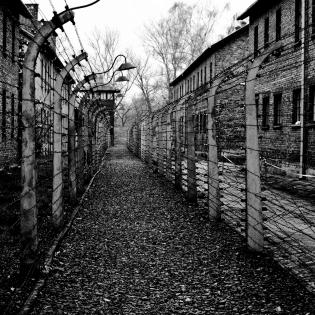Surviving Auschwitz (9-12)
This lesson focuses on two young Jewish survivors of Auschwitz-Birkenau, the Nazi death camp. As they return to their home town and the concentration camp, they each tell their story and explain why they were willing to return to such an emotionally devastating place. Their story is replete with examples of heroism and concern for others in the face of unspeakable sorrow.
The learner will:
- define oral history, describe its advantages and disadvantages, and explain its importance to overall history.
- evaluate the importance of the “final solution” to Hitler’s plans for Lebensraum.
- demonstrate how countless acts of inhumanity can minimize self-esteem in the oppressed yet bring out heroic acts of selflessness toward others.
- explain why it is important for the story of the Holocaust to be told.
- reflect on the importance of family during times of trauma.
- interpret another person’s need to tell her story so that the experiences of others will be better than her own.
- Overview of “Surviving Auschwitz: Children of the Shoah” (handout below)
- Letter to Families/Guardians (handout below)
- Video/DVD - Surviving Auschwitz: Children of the Shoah https://www.gvsu.edu/wgvustore/index.cfm

Prior to teaching this lesson, because of the sensitive nature of the topic and some of the images contained in this film, teachers are encouraged to consider sending the Letter to Families/Guardians (below) home with the students, giving the adult family members an opportunity to preview the film and discuss it with their child.
Because of the sensitive nature of the topic and some of the images contained in this film, adult family members are urged to preview the film, or view and discuss it with their child. A sample letter for Families is included Letter to Families/Guardians (below).
- Nieuwsma, Milton J. (ed.). Surviving Auschwitz: Children of the Shoah. New York: ibooks (distributed by Simon & Schuster), 1998.
- History Matters: Making Sense of Evidence Web page. “Making Sense of Oral History” by Linda Shopes.
-
Video/DVD - Surviving Auschwitz: Children of the Shoah https://www.gvsu.edu/wgvustore/index.cfm

Instructions
Anticipatory Set:
Put the term “oral history” on the board or overhead. Ask the learners to define it and give examples of history that have been handed down through this medium.
(ex., During the 1930s and 1940s the oral interviews of the Federal Writers Project documented the ways ordinary people were coping with the Great Depression.
Griots [gree-o] in West Africa were known as chroniclers of every event in their villages.They witnessed and mentally recorded the deeds of every person, which they passed down through time to other griots as oral history.)
Explain that oral history includes many types of story sources, such as:
- recorded interviews with individuals;
- formal, often-told accounts of the past presented by traditional story-tellers;
- informal conversations about "the old days" among family members or others;
- printed collections of stories told about past times.
Ask the learners why oral history is used as a way to understand the past. What information does it provide that ordinary histories cannot? Compare oral history to autobiographies and biographies which are other ways of learning about others.
It has been said that oral histories help democratize the historical record. What does this mean?
Why is it important to view history from a broader perspective rather than just from the point of view of important people in society or the media?
Remind learners that the interview for an oral history is based on the memories of the narrator. Information, at times, may not be as precise or defined as other historical accounts.It may be limited by the age or circumstance of the person remembering the events. Nevertheless, it is a legitimate form of history.
Read aloud Overview of “Surviving Auschwitz: Children of the Shoah” (handout below) to provide a background of the film that will be viewed.
Define/clarify vocabulary terms that learners will hear during the viewing (see Nieuwsma under Bibliographical References):
- Lebensraum (breathing space)
- ghetto (sections of a city where the Jews from the city and surrounding areas were forced to stay)
- concentration/extermination camp
- appell (roll call)
- Gestapo (German secret police)
- SS (policing unit of the Nazi party that staffed the concentration camps)
- Sammlungsstelle (collection and sorting place for Jewish property)
- Kinderlager (children’s camp at Auschwitz)
Video: Part One — Pre War to Slave Labor Camps (29 minute segment)
To focus the learners’ attention, ask them to think about the following questions while viewing the film:
- To return to these disturbing memories and locations of earlier life was traumatic for these women. Why would the women return and relive their past anguish?
- What did Hitler mean by a “final solution”? What evidences were there throughout the film of the Third Reich’s attitude toward the Jews?
- What were the many ways the Germans used the Jews to help their war effort?
- What did Tova mean when she said it was important for her to revisit the villages and camps to “get a reality check”?
After viewing this section of the video, discuss the above questions. Clarify any questions.
Reflection: T. S. Eliot is quoted: “We shall not cease from exploration and the end of all our exploring will be to arrive where we started and know the place for the first time.” Tova and Frieda went to the camps as children the first time. When they returned as adults, they learned to know the place for the first time. How was this possible?
Video: Part Two — Auschwitz (32 minute segment)
To focus the learners’ attention, ask them to think about the following questions while viewing the film:
- Those who deny that the Holocaust occurred say that it was impossible to kill six million people in such a short time. What evidence is shown that refutes that thinking?
- Tova said that it is a tragic thing to be a mother and not to be able to protect your child. What were the many ways that mothers tried to protect their children as best they could?
- During her trip to the crematorium, Tova said, “Being Jewish means dying. Being a child means dying.” How insignificant was the value of human life in the camps when a five year old child could make such a statement?
After viewing this section, discuss the above questions. Clarify any questions.
Reflection: Frieda remembers January 27, 1945, when the Soviets arrived and liberated the camp, as her “second” birthday. She said it was more important to her than her first birthday. Why does she feel that way?
Video: Part Three — After the War (27 minute segment)
To focus the learners’ attention during the viewing, ask the learners to think about the following questions while viewing the DVD:
- What conditions made a return to normal life difficult for the survivors?
- Even as the survivors tried to begin their lives again, loss of family was a continuing sorrow. What evidences are there in the film that the loss of family members affected them the rest of their lives?
- Why was Tova’s mother driven by the need to tell her story? What does re-telling one’s story to others accomplish?
After viewing this section, discuss the above questions. Clarify any questions.
Thinking Through the Enduring Ideas
The Germans imprisoned those they designated as racially or biologically inferior, those who resisted their domination and those who they judged to be politically unacceptable.
Concentration camps housed Soviet prisoners of war, German and Polish political prisoners/criminals, many Poles, Jews, Roma (gypsies), Jehovah’s Witnesses, homosexuals, physically disabled persons, Communists, democrats, Socialists, trade unionists, institutionalized psychiatric patients, and others considered security risks or undesirable by the Nazi state.
Debate the idea that no one is immune to violence and death when others are at risk.
Tova and Frieda did not just survive Auschwitz and the labor camps because they followed the rules and were “good” children. It was only through deliberate and desperate measures that they lived to see their liberation. There were many acts of heroism and giving (philanthropy), by those who knew them and those who did not, that kept them alive.
What were some of these examples of the giving of “time, talent and treasure” that saved their lives?
Tova and Frieda’s act of returning to Poland with their children was courageous and emotional. What did they hope to accomplish by returning? Were they successful?
Think of Tova and Frieda’s mothers, and the words they might have spoken to their grandchildren about their experiences.
Put yourself in their place and write an imaginary letter from one of them to her grandchildren. Express her thoughts about the past, her sacrifices on behalf of her own daughter, and her hopes for the future of her grandchildren.
Frieda closes by saying, “The world has not yet learned how not to allow the kind of violence and cruelty between people.” What evidences are there around the globe today that she is right?
Explain why the term genocide (the deliberate and systematic destruction of a racial, political, cultural, or religious group) has been used in discussions about recent world events. What are some recent events that have been labeled as genocide? How are these events similar/dissimilar to the story shown in this lesson?
Design and display a poster that focuses on one part of Frieda and Tova’s story. Rather than the gruesome images shown in the film, create the poster as a positive image that expresses their hope for a better world for children.
Frieda said, “I hope that, in some way, this story, through its horrors, will deter some of the anger, prejudice, hatred so that no other mother or father would have to go through this with their children. I hope that my children and grandchildren, nobody’s children or grandchildren, will ever have to go through anything like that.” She also asks us to “pray that this does not happen to any children any more in this world.” Reflect on Frieda’s hope and the experiences the two survivors experienced in their early years. Evaluate the importance of Frieda and Tova’s story with those who view this film. What attitudes and behaviors of others might be influenced through the sharing of their story?
Explore the injustices in the world today. There are individuals and populations who are misunderstood and mistreated (neglected, abused or bullied) in our country and around the world. Students investigate, plan, and take action to advocate for fair treatment.
Philanthropy Framework
-
Strand PHIL.II Philanthropy and Civil Society
-
Standard PCS 01. Self, citizenship, and society
-
Benchmark HS.2 Discuss and give examples of why some humans will sacrifice for the benefit of unknown others.
-
-
Standard PCS 02. Diverse Cultures
-
Benchmark HS.2 Give examples from history of how intolerance of ideas, religion, and minorities contributed to social disintegration.
-
-
Standard PCS 07. Skills of Civic Engagement
-
Benchmark HS.3 Participate in acts of democratic citizenship in the community, state or nation, such as petitioning authority, advocating, voting, group problem solving, mock trials or classroom governance and elections.
-
-
